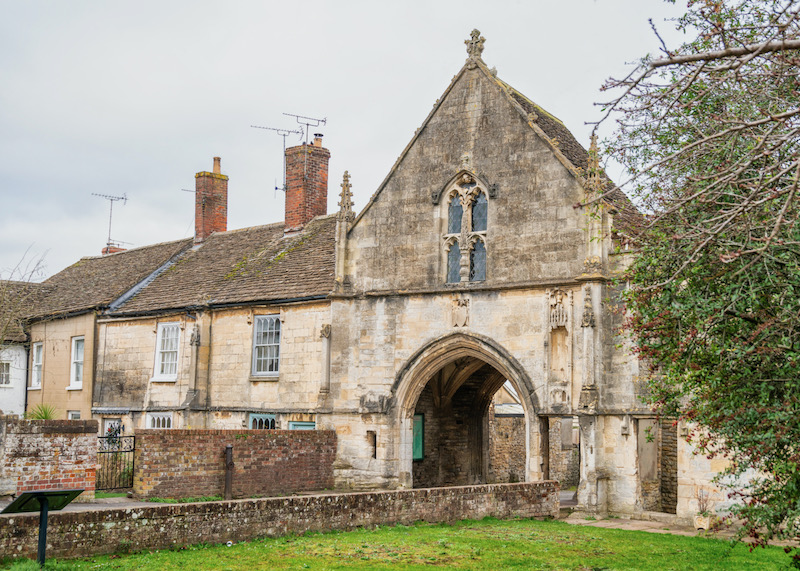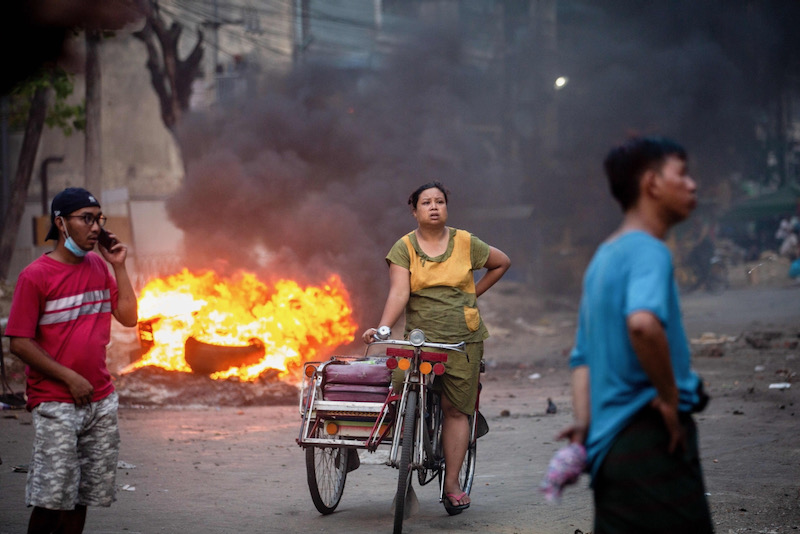Eight years ago today, on Palm Sunday 2013, I was received into the Catholic Church in St Mary’s Cathedral, Yangon, Myanmar, by the city’s Archbishop – who two years later became his country’s first Cardinal – Charles Bo.
At the time, it was a scene of serenity. Surrounded by friends from Myanmar’s different ethnic and religious groups – Buddhists, Muslims, Protestants as well as Catholics – as well as several foreign friends of no particular practicing religion, including a couple of lapsed Catholics who had not set foot in a church for decades, I felt a deep peace as Cardinal Bo poured the waters of baptism over my head and the cathedral bells rang out in welcome at my spiritual homecoming.
Outside the cathedral, it appeared that a new dawn was breaking in Myanmar too. Lord Alton of Liverpool travelled with me to the country, as my sponsor into the Church and for a political fact-finding visit as well. We did things that we may previously have dreamed but never dared believe would happen: we met democracy leader Aung San Suu Kyi, addressed a multi-ethnic, multi-religious gathering of civil society activists and were driven around the city by a former political prisoner turned taxi driver.
We were not naïve about the reforms we saw then, and indeed there were clear storm clouds alongside the sunrise. Shortly before our visit a terrible wave of anti-Muslim violence – a precursor to the subsequent Rohingya genocide – swept the country, and Lord Alton and I met Muslims in a village outside the capital, Naypyidaw, just a few days after their homes had been burned down. So we knew that Myanmar’s future contained grave challenges – most of all, how to build a sustainable, inclusive democracy reflective of the country’s ethnic and religious diversity. But nevertheless we were cautiously hopeful that Myanmar’s military had turned a corner, ending over half a century of direct military rule and ushering in the first seeds of democratic governance.
Today, the scene is very different. On 1 February the military seized direct power again in a coup, overturning the results of last November’s elections and imprisoning the legitimate representatives of the people. For much of the past two months, thousands of people have been on the streets daily, courageously protesting against the coup. They have been met with teargas, water cannon, batons, beatings, arrests and in the past few weeks, live ammunition and lethal force. By most verified estimates at least 300 have been killed – and the real death toll is likely to be much higher. Last week a seven year-old girl who posed no threat to the army, and who was in her own family’s home, was senselessly and cruelly shot dead. Yesterday, Armed Forces Day, was another day of lethal force and bloodshed, the worst since the coup, with at least 114 unarmed civilians murdered including a boy aged 5 and a girl aged 13. Almost 3,000 people have been arrested and detained, according to the Assistance Association for Political Prisoners.
Eight years ago, the streets around St Mary’s Cathedral rang with the sound of birdsong and bells. Now, they ring with the sound of gunfire and cries of terror. And yet the very courage and love that so attracted me to the Church in Myanmar are once again on full display today. The image of a nun, Sister Ann Roza Nu Tawng, kneeling on the street in Myitkyina in front of the security forces, her arms outstretched, pleading with them not to shoot the youth. The picture of a priest, Father Celso Ba Shwe, mediating between the police and demonstrators in Loikaw, Karenni State. The scenes of priests and nuns visibly amongst the protesters. And some truly powerful statements from Cardinal Bo.
It was that combination of courage, wisdom and love that I perceived in Cardinal Bo about a decade ago that drew me in to my surprising journey into Catholicism in Myanmar. It all started with a conversation with him over dinner, where his quiet, calm but brave defiance of the regime inspired me so much that I started to ask questions about the Catholic faith. I had already been a Christian since my university days, but after 19 years worshipping in the evangelical Anglican tradition, something in Cardinal Bo made be curious about Catholicism. He gave me a book of conversations between Peter Seewald and Pope Benedict XVI, called Light of the World, and to my surprise I asked what was the procedure for becoming a Catholic. At the time the question came more out of curiosity than conscious intention, but his response struck me by its generosity and simplicity. “When a person can accept the teachings of the Catholic Church, they are ready to become a Catholic”, he said. As that straight-forward but profound remark sank in, he added something that changed my life: “If you ever find yourself in that position, I would receive you into the Church here in Myanmar.”
A few days later I went to Mass in the cathedral and, knowing that I would be there, Cardinal Bo was there too: but not as the celebrant, not in his archbishop’s chair, but simply in the congregation, a shepherd amidst his flock. At the end of Mass, he gave me a big smile, offered me a tour of the cathedral and invited me back to his residence for a glass of whisky.
A few days later I was deported from Myanmar by the regime. But Cardinal Bo’s invitation into the Church lingered in my mind. I knew that friendship with one particular archbishop was not a good enough reason by itself to become a Catholic, but I resolved that if I wanted to take his invitation seriously – in a sense regardless of the end result – I needed to investigate further. And so I embarked on a two-year journey of exploration, reading everything from the Catechism to encyclicals, from Thomas Merton, St John Henry Newman, Henri de Lubac and Hans Urs von Balthasar to GK Chesterton, Malcolm Muggeridge and Scott Hahn. Two priests and several lay Catholic friends guided me, patiently answering questions regularly as I probed, read, thought, prayed and explored. Along the way, despite my deportation, I got back into Myanmar and resumed my conversations with Cardinal Bo, and he gave me the Compendium of the Social Doctrine of the Church – which I could hardly put down. For the first time here was a single volume that said almost everything I already believed about the Christian imperative to seek justice and defend freedom and human dignity.
Ever since I first became a Christian my faith has been forged on the contours of the fight for freedom. As a student I discovered Christian faith and a vocation for defending human rights almost simultaneously. Two of my friends have been assassinated, some jailed, many displaced or exiled. I have worked for human rights across Asia, in China, Hong Kong, North Korea, Indonesia, Pakistan, The Maldives, Bangladesh and Sri Lanka. One of my closest friends from Myanmar, Dr Sasa, whom I have known for 15 years, has suddenly become an international face and voice for the country’s democracy movement, and has been charged with “high treason” as a consequence. And one of my most significant enduring mentors, allies and sources of inspiration in both my spiritual and advocacy life continues to be Cardinal Bo.
As I look at Myanmar today – a decade of fragile reform undone, a nation plunged back into the darkness of dictatorship from which they thought they were beginning to emerge, a country of shattered dreams and yet fierce resolve, a people so often divided by ethnicity and religion now united against injustice – I weep, and yet I hold on to hope. I pray, in the words of Cardinal Bo’s recent Global Day of Prayer for Myanmar message, “for a new Myanmar to be born out of this current tragedy, a Myanmar where truly every human being has an equal stake in the country and equal rights to basic freedoms, a Myanmar where ethnic and religious diversity is celebrated and where we enjoy real peace, a Myanmar where the soldiers put down their guns, step back from power and do what an army is meant to do: defend rather than attack the people. … A Myanmar that rises again from the ashes.”
As we prepare to enter Holy Week, Myanmar – my spiritual home – provides a living human example of the Way of the Cross. A nation that has suffered so many decades on Calvary and Golgotha had, over the past decade, not quite reached Easter but was beginning at least to emerge from the tomb. Now, as it enters another Calvary, I pray that this time it will not last long, and that its resurrection will be more genuine and more durable. And as I pray, the bells of St Mary’s Cathedral, Yangon, ring in my heart as the words of Cardinal Bo as he breathed over me that Palm Sunday echo in my mind: “Peace be with you”. May we all pray for peace – with freedom and justice – for Myanmar today.
Benedict Rogers is a human rights activist and writer. He is the co-founder and Chief Executive of Hong Kong Watch, Senior Analyst for East Asia at the international human rights organisation CSW, co-founder and Deputy Chair of the UK Conservative Party Human Rights Commission, a member of the advisory group of the Inter-Parliamentary Alliance on China (IPAC) and a founding trustee of Hong Kong ARC. He is the author of six books, including three on Myanmar, and his faith journey is told in his book “From Burma to Rome: A Journey into the Catholic Church” (Gracewing, 2015).



 Loading ...
Loading ...
What do you think?
You can post as a subscriber user ...
User comments (1)
Thank you for your article on the Dublin Mater and the role Mother Vincent Whitty played in its establishment as well as her contribution to the training of nurses.
A minor clarification: Whilst Sr Mary Aloysius Doyle was in 1897 the last surviving Irish Sister of Mercy to serve in the Crimea, there were other surviving Sisters in England who were also awarded the Royal Red Cross. 'The Nursing Record and Hospital World' of 17 July, 1897 reports “Her Majesty has conferred the decoration of the Royal Red Cross upon Nursing Sisters Mary Helen Ellis, Mary Stanislaus Jones, Mary Anastasia Kelley, and Mary de Chantal Huddon, in recognition of their services in tending the sick and wounded at the seat of war during the Crimean campaign of 1854- 1856. It may be of interest to the public to learn that these sisters have received this decoration as being the only survivors of the Roman Catholic sisters who gave their services in nursing our soldiers during the Crimean War, over 40 years ago....The three first-named...were on their return from the East, asked to undertake the nursing of a hospital...in Great Ormond Street.”
Another Sister who had served in the Crimea, Sr M Elizabeth Hercy, a native of Berkshire, who had entered the Sisters of Mercy in Baggot St, Dublin, followed Mother Vincent Whitty to Brisbane. Sr Elizabeth Hercy lived in Brisbane until her death in 1901 and was also awarded the Royal Red Cross. Her award is on display at Mercy Heritage Centre, Brisbane.